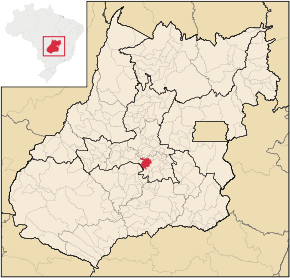Trindade (Goiás)
| Trindade (Goiás) | |
|---|---|
| Basic data | |
| State : | Goiás |
| Area : | 719 km² |
| Residents : | 104.506 |
| Population density : | 145.3 inhabitants / km² (2010) |
| Height : | 756 m |
| Post code (CEP): | 75380-000 |
| Telephone code : | +55 62 |
| Geographic location : | 16 ° 38 's. Br. 49 ° 29 'w. L. |
| Gross domestic product : | R $ 390 million (2007) |
| GDP per capita: | R $ 4,060 (2007) |
| City administration address: | Governo Municipal de Trindade (Prefeitura) Praça Constantino Xavier nº 330 - Centro (Go 3506-7000) |
| Official website: | www.trindade.go.gov.br |
| politics | |
| map | |
Trindade (Goiás) is a city and municipality ( port .: Município ) in Brazil in the state of Goiás with an area of 719 km². It belongs to the Goiânia metropolitan area .
According to statistical surveys from 2010, 104,506 inhabitants were determined. Trindade (Trinity) gained national fame through the approximately 18 km long pilgrimage route O caminho da fé "Path of Faith" from Goiania to Trindade.
Geographical location
Trindade is about 15 km west of Goiânia at an altitude of 756 m and is part of the periphery of Goiania. The mean annual temperature is 23 ° C with an average annual rainfall of 1600 mm / year.
Pilgrimage and parish
The pilgrimage route starts in Goiania and ends in Trindade and is lined with 14 monumental sculptures by the artist Omar Souto, which symbolize the sufferings of Christ.
In the center of the city is the half-timbered basilica "Igreja Matriz" from the nineteenth century. According to historical information, it is at the place where Constantino Xavier found a medallion in the clay in 1840, which depicts the coronation of the Virgin Mary by the Holy Trinity. The medallion and its place of discovery are said to have wonderful powers. Soon afterwards the first pilgrims arrived and a pilgrimage chapel was built to house the find. According to Oscar Leal, 15,000 pilgrims were counted in 1890.
In the course of the growing number of pilgrims, the foundation stone for the modern and spacious Basilica do Divino Pai Eterno e Trindade was laid in 1943. On the basilica hill is the installation of a pilgrimage grotto in honor of the Virgin of Lourdes, built in 2005.
Close to the modern basilica, as part of church facilities, there are accommodations for church employees, nuns and monks as well as sanatoriums and nursing homes for the socially needy. Part of the financial and material needs to maintain these facilities are met by visitors and large parts of the population.
history
Settlement began after the decline of gold exploration around the end of the eighteenth century when gold prospectors settled in the region in search of cultivable land. At that time the region was called "barro preto" and means something like black clay. Barro Preto was administered at that time by the district authority in Santa Cruz, which was founded in 1776. After the Marian medallion was found in 1840, the number of pilgrims increased steadily. The processions took place without Catholic priests until 1891 and aroused the suspicion of the Bishop of Goiás Dom Eduardo Silva. Finally, in 1894, German missionaries of the Redemptorist Order were called, who after initial difficulties in 1895 founded a monastery near the chapel "Igreja Matriz de Campinas". The aim of the missionary activity in Trindade was to lead the pilgrims' procession through Catholic priests and clergy.
Web links
Individual evidence
- ↑ Results of the 2010 census in Goiás (PDF; 30 kB), carried out by IBGE .
